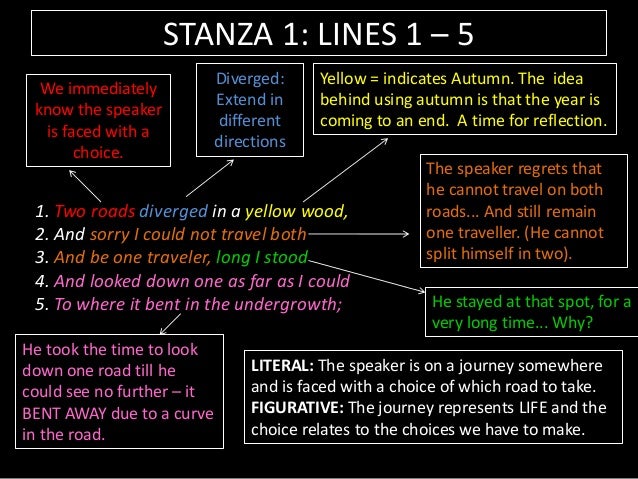

These moments, however, remains conditioned by the fact that they take place within a particular circumstance within a particular wood in which their consequences can never be fully known. Rather, life itself is presented as being a build up of sedimented consequences which follow from other consequences and which only offer brief moments of stillness in which a decision can be made. Specifically, the repetition of the word “way” serves to enact the poem’s suggestion that action follow from action and that this very fact means that it is frequently impossible to return to the previous opportunist once they have been missed. Frost again uses repetition in these lines in order to suggest the passage of time and the sedimentation of experience within a single character. In the middle of the third stanza he exclaims “Oh, I kept the first for another day!” before immediately qualifying this with the lines “Yet, knowing how way leads on to way, / I doubted if I should ever come back” (ibid). The following stanzas of the poem show Frost attempting to comfort himself as to the non-final nature of his decision and him inevitably coming to realize that it is, in fact, irrevocable. Need A Unique Essay on "The Road Not Taken: Analysis" ? Use Promo "custom20" And Get 20% Off! Order Now
TH ROAD NOT TAKEN ANALYSIS FULL
This inability to know the full consequences of a decision clearly does not alleviate the necessity to making it.

The opaque nature of this possibility made clear by the final line of the poem in which Frost describes how he started down the one path until it “bent into the undergrowth” (ibid). This idea if made clear through the repetition and elongation of the word “travel” into “one traveller.” Frost notes that he is not able to take both roads and remain one person, and in this sense suggests that the necessity of remaining an individual necessarily involves loss and forsaken possibility. one in which they have only two choices, these opening lines already set up the key conceptual idea of the poem: that individuals are forced to make choices which, although inconspicuous, come to define them as people. Aside from placing the speaker of the poem in a completely enclosed situation, i.e. Frost immediately places the reader within the moment of this decision and writes: “Two roads diverged in a yellow wood, And sorry I could not travel both / And be one traveller, long I stood” (2002, p. The poem begins with simple lines that place the traveller in a wood and presents them as needing to make a decision. By demonstrating the manner in which an individual is faced with a simple choice which, eventually, may come to define them, the poem is both a commentary on subjective autonomy and also a lament over the way in this autonomy must exercize itself in restricted and unknowable conditions. The language is simple and accessible, though the ideas are more complex than they seem.Robert Frost’s The Road Not Taken is a poem that deals with the nature of contingency, action and the manner in which seemingly inconspicuous rescissions may come to form an integral part of a person’s life. The voice is that of the poet or narrator, using the first person ‘I’. The rhythm is varied there is no clear metrical pattern, but strong use of enjambment creates a ‘conversational’ flow that is intimate and seems informal, as if the poet is ‘talking’ to the reader. The poem comprises four stanzas of five lines each, known as quintains. Yet it became popular … taken to be an inspiring poem, which sounds noble and is really mischievous ( Frost: A Literary Life Reconsidered, 1984) Frost did on occasion warn his … audiences that it was a tricky poem. characterized himself in that poem particularly as ‘fooling my way along.’ He also said that it was really about his friend (English poet) Edward Thomas, who when they walked together always castigated himself for not having taken another path than the one they took. The last line of the poem is, of course, ambiguous. There is no right answer and we will always wonder subsequently if there was a better route.

Taught in high school classrooms across the English-speaking world, it’s become popular as a depiction of rugged individuality, of “straying from the beaten path.”īut is it that simple? Careful reading will show Frost’s intention to convey that whatever path, whatever decision in life, is taken by the listener or reader, it will leave them wondering if the alternative would have been better. One of the most widely quoted poems ever written, “The Road Not Taken” was completed in 1915 and first published in Frost’s volume Mountain Interval (1916).


 0 kommentar(er)
0 kommentar(er)
